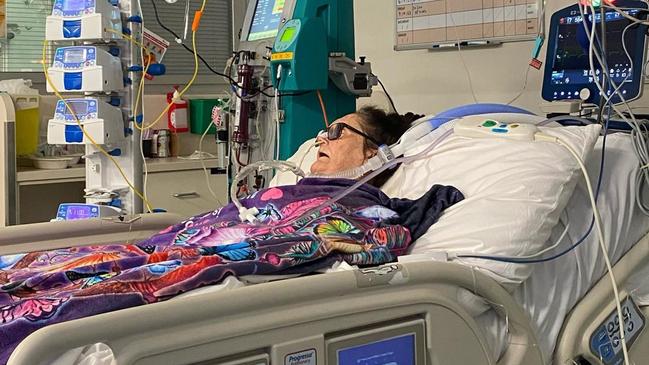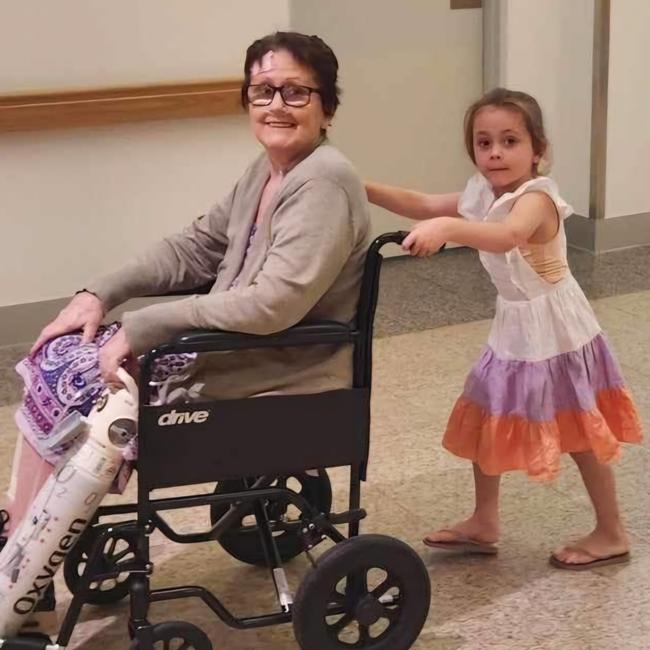Tracey McNee: Howard Springs grandmother shares battle with sepsis and post-sepsis syndrome
An NT woman says she doesn’t know whether she’s blessed or cursed after spending months clinging to life in the ICU, having early retirement forced upon her, then living with the ghastly legacy of post-sepsis syndrome.

Northern Territory
Don't miss out on the headlines from Northern Territory. Followed categories will be added to My News.
A Howard Springs woman says she doesn’t know whether to feel blessed or cursed after spending four months clinging to life in hospital due to sepsis, having early retirement forced upon her, and then living with the ghastly legacy of post-sepsis syndrome.
Sharing her story to coincide with Friday’s World Sepsis Day, grandmother Tracey McNee, 62, said she began feeling ill with what seemed like flu on a Friday last March.
When her husband woke up the following day – she doesn’t remember this, but has pieced it together from ex post facto accounts – Ms McNee was white as a sheet and requested to go to the hospital because her chest was in such pain.
By Saturday afternoon, it was clear she had sepsis, and she was rushed from Palmerston Regional Hospital to Royal Darwin’s intensive care unit.
Two days later, Ms McNee died.
“There was total organ failure including my heart – I actually died for five to 10 seconds,” she said.
“My kidneys failed, lungs collapsed, you name it, I had it.
“I cannot over-exaggerate how marvellous the ICU team at the Royal is.”

The 122 days Ms McNee spent in hospital was just the start of her battle – in addition to losing her toe from the condition, she was also left with the debilitating post-sepsis syndrome, which the US-based Sepsis Alliance says can affect up to 50 per cent of survivors.
“It causes muscle and joint pain, so bad it can be a disability, fatigue, and I’ve only got 40 per cent lung capacity so 24/7 I rely on oxygen,” Ms McNee said.
“Seventeen months on, I am still wonky on my feet.”
The severity of her syndrome is such that she has had to give up her beloved job at Miwatj Health Aboriginal Corporation, which has placed pressure on the household finances.
Asked whether she felt lucky to survive or unlucky to have gotten the condition, Ms McNee was momentarily stumped.
“It’s been such a hard road, sometimes you feel like giving up and asking why did I survive,” she said.
“I can’t answer that question.
“I feel lucky to be alive because I’ve got a beautiful granddaughter and I want to see her grow.
“That was my fight and determination, watching her grow.”
Ms McNee said she was sharing her story in the hope governments of all persuasions would consider funding a national post-sepsis syndrome program, which does not currently exist, meaning she has had to fly blind in co-ordinating her own rehabilitation.
According to advocacy body Sepsis Australia, the condition kills 8700 Australians each year, and has a one-in-three death rate.
Professor Simon Finfe, professorial fellow at Sepsis Australia, said sepsis – when the body attacks its own cells in the midst of an infection – often stemmed from respiratory, abdominal, or urinary infections, but any infection, including Covid-19, could trigger it.
Symptoms include fever or chills, rapid breathing or heartbeat, rashes, drowsiness, confusion or disorientation, and not passing any urine.




